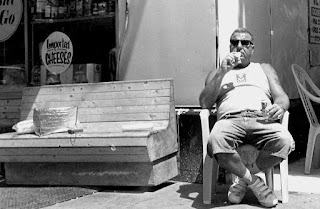Okay. You contact the seller who agrees to let you have one of the cameras for $75. But which one? Because the seller claims that she "knows nothing about photography," and "can't tell the difference between the two cameras," you'll have to do a little research before you make your choice.
At first glance both cameras appear to be identical twins. But then you discover that the camera shown on top in the photo (left) has two tiny screws in its top plate (blue) while the second camera has none.
You notice, also, that the black metal band under the top plate of the bottom camera (red dot) doesn't appear on its mate. That's it so far.
Serial number 616166 on the top cover of the Leica indicates that it's a Leica IIIf and that it was manufactured between 1951-1952. Serial number 126558 on the Nicca Type-5 reveals that it was manufactured during 1955.
Interestingly, although you can't tell from the photo, the viewfinder magnification lever on the Nicca (black dot) is more finely crafted than the one on the Leica. By contrast, the shutter speed dial on the Leica is more polished than that of the Nicca.
What's more, the shutter speed dial on the Leica is larger than the one on the Nicca. The Leica's dial also makes it possible to set the shutter at 75, while the dial on the Nicca skips from 50 to 100. The range of speeds on both cameras, however, is T-1000. Another difference is that there's a series of red numbers spaced around the Leica's dial. These numbers cite the camera's adjustable flash contact scale. There are slight differences between the two cameras' A/R levers (blue dots, above) and more significant differences between their film advance knobs.
But you can see the most striking external differences between the two cameras when you view them from the rear. Note the differences between the two eyepieces and the positions of the flash synch plugs. And then there are those two tiny screws on the top plate of the Leica. And of course there's that
 wonderful swing back on the Nicca (red dot) that makes loading film into the camera much easier than it is on the bottom loading Leica.
wonderful swing back on the Nicca (red dot) that makes loading film into the camera much easier than it is on the bottom loading Leica.Not being technically oriented, I don't know which of the two cameras is better from the point of view of mechanics. But the fact that they're still functioning perfectly after sixty or more years have passed indicates that the Japanese Nicca is at least as hardy as the German Leica.
If I had to choose between them, which of these two fine cameras would I prefer? Now don't get me wrong. I've used--and loved--several different Leicas for many years. But in this case, I'd most likely select the Nicca Type-5
even though the Leica IIIf is the most advanced, most popular screw mount. Leica. Why? That's a no brainer. Just take another look at the Nicca's swing back door.
 | |||||
| Is this a Leica photo or a Nicca photo? |


Great post. The Nicca Type-5 was made in 1955 so it's a bit doubtful that its from late 1959. Nicca had been acquired by Yashica in late 1958. Your post is correct when you state that the Nicca 5L is the hardest to find (if not impossible). The 5L was released in 1957.
ReplyDeleteHello,
DeleteThanks for your comment. Your are correct. I've noted "1955" in the text. I did a bit more research and found that the Nicca Type 5 was made for two years, 1955 and 1956. The 1265558 serial number on the example shown in the blog places it in "55. Again, thanks.